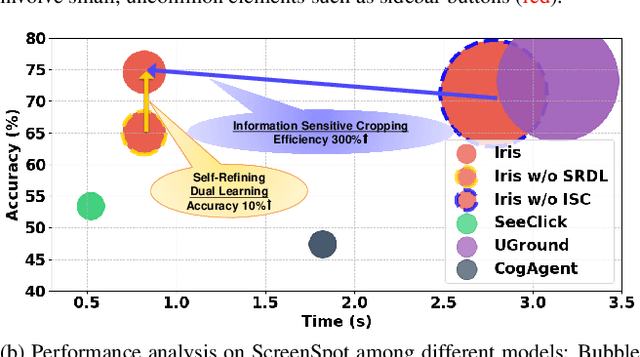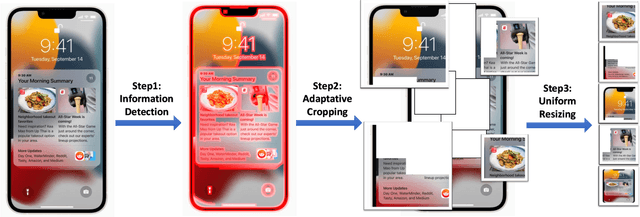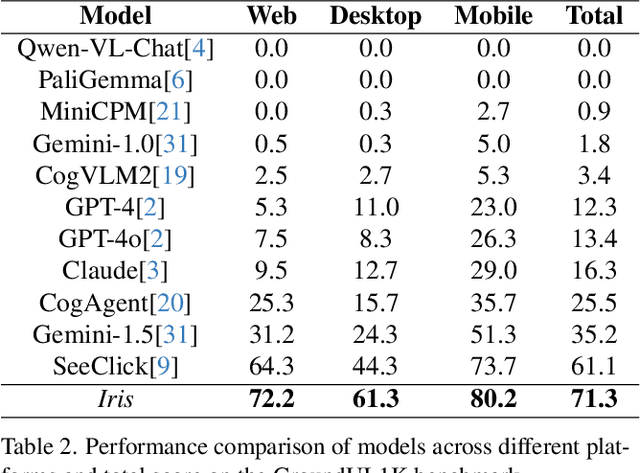Juncheng Li
Benchmarking Multimodal CoT Reward Model Stepwise by Visual Program
Apr 09, 2025Abstract:Recent advancements in reward signal usage for Large Language Models (LLMs) are remarkable. However, significant challenges exist when transitioning reward signal to the multimodal domain, including labor-intensive annotations, over-reliance on one-step rewards, and inadequate evaluation. To address these issues, we propose SVIP, a novel approach to train a step-level multi-dimensional Chain-of-Thought~(CoT) reward model automatically. It generates code for solving visual tasks and transforms the analysis of code blocks into the evaluation of CoT step as training samples. Then, we train SVIP-Reward model using a multi-head attention mechanism called TriAtt-CoT. The advantages of SVIP-Reward are evident throughout the entire process of MLLM. We also introduce a benchmark for CoT reward model training and testing. Experimental results demonstrate that SVIP-Reward improves MLLM performance across training and inference-time scaling, yielding better results on benchmarks while reducing hallucinations and enhancing reasoning ability.
Boosting Virtual Agent Learning and Reasoning: A Step-wise, Multi-dimensional, and Generalist Reward Model with Benchmark
Mar 24, 2025Abstract:The development of Generalist Virtual Agents (GVAs) powered by Multimodal Large Language Models (MLLMs) has shown significant promise in autonomous task execution. However, current training paradigms face critical limitations, including reliance on outcome supervision and labor-intensive human annotations. To address these challenges, we propose Similar, a Step-wise Multi-dimensional Generalist Reward Model, which offers fine-grained signals for agent training and can choose better action for inference-time scaling. Specifically, we begin by systematically defining five dimensions for evaluating agent actions. Building on this framework, we design an MCTS-P algorithm to automatically collect and annotate step-wise, five-dimensional agent execution data. Using this data, we train Similar with the Triple-M strategy. Furthermore, we introduce the first benchmark in the virtual agent domain for step-wise, multi-dimensional reward model training and evaluation, named SRM. This benchmark consists of two components: SRMTrain, which serves as the training set for Similar, and SRMEval, a manually selected test set for evaluating the reward model. Experimental results demonstrate that Similar, through its step-wise, multi-dimensional assessment and synergistic gain, provides GVAs with effective intermediate signals during both training and inference-time scaling. The code is available at https://github.com/Galery23/Similar-v1.
Learning 4D Panoptic Scene Graph Generation from Rich 2D Visual Scene
Mar 19, 2025Abstract:The latest emerged 4D Panoptic Scene Graph (4D-PSG) provides an advanced-ever representation for comprehensively modeling the dynamic 4D visual real world. Unfortunately, current pioneering 4D-PSG research can primarily suffer from data scarcity issues severely, as well as the resulting out-of-vocabulary problems; also, the pipeline nature of the benchmark generation method can lead to suboptimal performance. To address these challenges, this paper investigates a novel framework for 4D-PSG generation that leverages rich 2D visual scene annotations to enhance 4D scene learning. First, we introduce a 4D Large Language Model (4D-LLM) integrated with a 3D mask decoder for end-to-end generation of 4D-PSG. A chained SG inference mechanism is further designed to exploit LLMs' open-vocabulary capabilities to infer accurate and comprehensive object and relation labels iteratively. Most importantly, we propose a 2D-to-4D visual scene transfer learning framework, where a spatial-temporal scene transcending strategy effectively transfers dimension-invariant features from abundant 2D SG annotations to 4D scenes, effectively compensating for data scarcity in 4D-PSG. Extensive experiments on the benchmark data demonstrate that we strikingly outperform baseline models by a large margin, highlighting the effectiveness of our method.
SOYO: A Tuning-Free Approach for Video Style Morphing via Style-Adaptive Interpolation in Diffusion Models
Mar 10, 2025Abstract:Diffusion models have achieved remarkable progress in image and video stylization. However, most existing methods focus on single-style transfer, while video stylization involving multiple styles necessitates seamless transitions between them. We refer to this smooth style transition between video frames as video style morphing. Current approaches often generate stylized video frames with discontinuous structures and abrupt style changes when handling such transitions. To address these limitations, we introduce SOYO, a novel diffusion-based framework for video style morphing. Our method employs a pre-trained text-to-image diffusion model without fine-tuning, combining attention injection and AdaIN to preserve structural consistency and enable smooth style transitions across video frames. Moreover, we notice that applying linear equidistant interpolation directly induces imbalanced style morphing. To harmonize across video frames, we propose a novel adaptive sampling scheduler operating between two style images. Extensive experiments demonstrate that SOYO outperforms existing methods in open-domain video style morphing, better preserving the structural coherence of video frames while achieving stable and smooth style transitions.
Chart-HQA: A Benchmark for Hypothetical Question Answering in Charts
Mar 07, 2025Abstract:Multimodal Large Language Models (MLLMs) have garnered significant attention for their strong visual-semantic understanding. Most existing chart benchmarks evaluate MLLMs' ability to parse information from charts to answer questions. However, they overlook the inherent output biases of MLLMs, where models rely on their parametric memory to answer questions rather than genuinely understanding the chart content. To address this limitation, we introduce a novel Chart Hypothetical Question Answering (HQA) task, which imposes assumptions on the same question to compel models to engage in counterfactual reasoning based on the chart content. Furthermore, we introduce HAI, a human-AI interactive data synthesis approach that leverages the efficient text-editing capabilities of LLMs alongside human expert knowledge to generate diverse and high-quality HQA data at a low cost. Using HAI, we construct Chart-HQA, a challenging benchmark synthesized from publicly available data sources. Evaluation results on 18 MLLMs of varying model sizes reveal that current models face significant generalization challenges and exhibit imbalanced reasoning performance on the HQA task.
The Best of Both Worlds: Integrating Language Models and Diffusion Models for Video Generation
Mar 06, 2025Abstract:Recent advancements in text-to-video (T2V) generation have been driven by two competing paradigms: autoregressive language models and diffusion models. However, each paradigm has intrinsic limitations: language models struggle with visual quality and error accumulation, while diffusion models lack semantic understanding and causal modeling. In this work, we propose LanDiff, a hybrid framework that synergizes the strengths of both paradigms through coarse-to-fine generation. Our architecture introduces three key innovations: (1) a semantic tokenizer that compresses 3D visual features into compact 1D discrete representations through efficient semantic compression, achieving a $\sim$14,000$\times$ compression ratio; (2) a language model that generates semantic tokens with high-level semantic relationships; (3) a streaming diffusion model that refines coarse semantics into high-fidelity videos. Experiments show that LanDiff, a 5B model, achieves a score of 85.43 on the VBench T2V benchmark, surpassing the state-of-the-art open-source models Hunyuan Video (13B) and other commercial models such as Sora, Keling, and Hailuo. Furthermore, our model also achieves state-of-the-art performance in long video generation, surpassing other open-source models in this field. Our demo can be viewed at https://landiff.github.io/.
AEIA-MN: Evaluating the Robustness of Multimodal LLM-Powered Mobile Agents Against Active Environmental Injection Attacks
Feb 18, 2025Abstract:As researchers continuously optimize AI agents to perform tasks more effectively within operating systems, they often neglect to address the critical need for enabling these agents to identify "impostors" within the system. Through an analysis of the agents' operating environment, we identified a potential threat: attackers can disguise their attack methods as environmental elements, injecting active disturbances into the agents' execution process, thereby disrupting their decision-making. We define this type of attack as Active Environment Injection Attack (AEIA). Based on this, we propose AEIA-MN, an active environment injection attack scheme that exploits interaction vulnerabilities in the mobile operating system to evaluate the robustness of MLLM-based agents against such threats. Experimental results show that even advanced MLLMs are highly vulnerable to this attack, achieving a maximum attack success rate of 93% in the AndroidWorld benchmark.
MAKIMA: Tuning-free Multi-Attribute Open-domain Video Editing via Mask-Guided Attention Modulation
Dec 28, 2024



Abstract:Diffusion-based text-to-image (T2I) models have demonstrated remarkable results in global video editing tasks. However, their focus is primarily on global video modifications, and achieving desired attribute-specific changes remains a challenging task, specifically in multi-attribute editing (MAE) in video. Contemporary video editing approaches either require extensive fine-tuning or rely on additional networks (such as ControlNet) for modeling multi-object appearances, yet they remain in their infancy, offering only coarse-grained MAE solutions. In this paper, we present MAKIMA, a tuning-free MAE framework built upon pretrained T2I models for open-domain video editing. Our approach preserves video structure and appearance information by incorporating attention maps and features from the inversion process during denoising. To facilitate precise editing of multiple attributes, we introduce mask-guided attention modulation, enhancing correlations between spatially corresponding tokens and suppressing cross-attribute interference in both self-attention and cross-attention layers. To balance video frame generation quality and efficiency, we implement consistent feature propagation, which generates frame sequences by editing keyframes and propagating their features throughout the sequence. Extensive experiments demonstrate that MAKIMA outperforms existing baselines in open-domain multi-attribute video editing tasks, achieving superior results in both editing accuracy and temporal consistency while maintaining computational efficiency.
Boosting Private Domain Understanding of Efficient MLLMs: A Tuning-free, Adaptive, Universal Prompt Optimization Framework
Dec 27, 2024Abstract:Efficient multimodal large language models (EMLLMs), in contrast to multimodal large language models (MLLMs), reduce model size and computational costs and are often deployed on resource-constrained devices. However, due to data privacy concerns, existing open-source EMLLMs rarely have access to private domain-specific data during the pre-training process, making them difficult to directly apply in device-specific domains, such as certain business scenarios. To address this weakness, this paper focuses on the efficient adaptation of EMLLMs to private domains, specifically in two areas: 1) how to reduce data requirements, and 2) how to avoid parameter fine-tuning. Specifically, we propose a tun\textbf{\underline{I}}ng-free, a\textbf{\underline{D}}aptiv\textbf{\underline{E}}, univers\textbf{\underline{AL}} \textbf{\underline{Prompt}} Optimization Framework, abbreviated as \textit{\textbf{\ourmethod{}}} which consists of two stages: 1) Predefined Prompt, based on the reinforcement searching strategy, generate a prompt optimization strategy tree to acquire optimization priors; 2) Prompt Reflection initializes the prompt based on optimization priors, followed by self-reflection to further search and refine the prompt. By doing so, \ourmethod{} elegantly generates the ``ideal prompts'' for processing private domain-specific data. Note that our method requires no parameter fine-tuning and only a small amount of data to quickly adapt to the data distribution of private data. Extensive experiments across multiple tasks demonstrate that our proposed \ourmethod{} significantly improves both efficiency and performance compared to baselines.
Iris: Breaking GUI Complexity with Adaptive Focus and Self-Refining
Dec 13, 2024



Abstract:Digital agents are increasingly employed to automate tasks in interactive digital environments such as web pages, software applications, and operating systems. While text-based agents built on Large Language Models (LLMs) often require frequent updates due to platform-specific APIs, visual agents leveraging Multimodal Large Language Models (MLLMs) offer enhanced adaptability by interacting directly with Graphical User Interfaces (GUIs). However, these agents face significant challenges in visual perception, particularly when handling high-resolution, visually complex digital environments. This paper introduces Iris, a foundational visual agent that addresses these challenges through two key innovations: Information-Sensitive Cropping (ISC) and Self-Refining Dual Learning (SRDL). ISC dynamically identifies and prioritizes visually dense regions using a edge detection algorithm, enabling efficient processing by allocating more computational resources to areas with higher information density. SRDL enhances the agent's ability to handle complex tasks by leveraging a dual-learning loop, where improvements in referring (describing UI elements) reinforce grounding (locating elements) and vice versa, all without requiring additional annotated data. Empirical evaluations demonstrate that Iris achieves state-of-the-art performance across multiple benchmarks with only 850K GUI annotations, outperforming methods using 10x more training data. These improvements further translate to significant gains in both web and OS agent downstream tasks.
 Add to Chrome
Add to Chrome Add to Firefox
Add to Firefox Add to Edge
Add to Edge